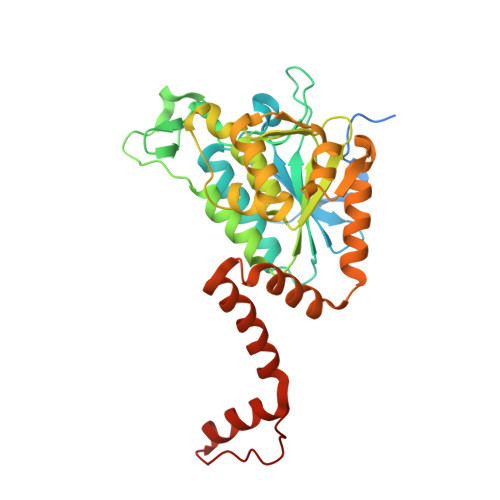Ligand-dependent active-site closure revealed in the crystal structure of Mycobacterium tuberculosis MenB complexed with product analogues
Song, H., Sung, H.P., Tse, Y.S., Jiang, M., Guo, Z.H.(2014) Acta Crystallogr D Biol Crystallogr 70: 2959-2969
- PubMed: 25372686
- DOI: https://doi.org/10.1107/S1399004714019440
- Primary Citation of Related Structures:
4QII, 4QIJ - PubMed Abstract:
1,4-Dihydroxy-2-naphthoyl coenzyme A (DHNA-CoA) synthase catalyzes an essential intramolecular Claisen condensation in menaquinone biosynthesis and is an important target for the development of new antibiotics. This enzyme in Mycobacterium tuberculosis is cofactor-free and is classified as a type II DHNA-CoA synthase, differing from type I enzymes, which rely on exogenous bicarbonate for catalysis. Its crystal structures in complex with product analogues have been determined at high resolution to reveal ligand-dependent structural changes, which include the ordering of a 27-residue active-site loop (amino acids 107-133) and the reorientation of the carboxy-terminal helix (amino acids 289-301) that forms part of the active site from the opposing subunit across the trimer-trimer interface. These structural changes result in closure of the active site to the bulk solution, which is likely to take place through an induced-fit mechanism, similar to that observed for type I DHNA-CoA synthases. These findings demonstrate that the ligand-dependent conformational changes are a conserved feature of all DHNA-CoA synthases, providing new insights into the catalytic mechanism of this essential tubercular enzyme.
- Department of Chemistry and State Key Laboratory of Molecular Neuroscience, The Hong Kong University of Science and Technology, Clear Water Bay, Kowloon, Hong Kong SAR, People's Republic of China.
Organizational Affiliation:


















